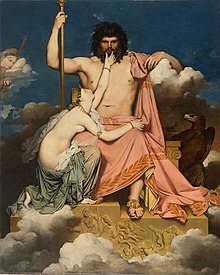Modern understanding of Greek mythology
Heyne approached the myth as a philologist and shaped the educated Germans' conception of antiquity for nearly half a century, during which ancient Greece exerted an intense influence on intellectual life in Germany.[3] Evans himself, while studying the Minoan world, drew regularly on Egyptian and Near Eastern evidence for comparison, and the discovery of the Hittite and Ugaritic civilizations has uncovered texts as well as monuments which offer comparative material for ritual and mythology.[7] Carl Jung extended the transhistorical, psychological approach with his theory of the "collective unconscious" and the archetypes (inherited "archaic" patterns), often encoded in myth, that arise out of it.In 1891, he claimed that "the most important discovery which has been made during the nineteenth century with respect to the ancient history of mankind [...] was this sample equation: Sanskrit Dyaus-pitar = Greek Zeus = Latin Jupiter = Old Norse Tyr".Meyer Reinhold argues that "such Near Eastern theogonic concepts, involving divine succession through violence and generational conflicts for power, found their way—the route is not certain—into Greek mythology.[20] In addition to Indo-European and Near Eastern origins, some scholars have speculated on the debts of Greek mythology to the still poorly understood pre-Hellenic societies of Greece, such as the Minoans and so-called Pelasgians.Historians of religion were fascinated by a number of apparently ancient configurations of myth connected with Crete: the god as bull—Zeus and Europa; Pasiphaë who yields to the bull and gives birth to the Minotaur; agrarian mysteries with a sacred marriage (Demeter's union with Iasion) etc.; the Titans and then the Olympians) suggest a distant echo of a struggle between social groups, mirroring the three major high cultures of Greek civilization: Minoan, Mycenaean and Hellenic.[22] Nevertheless, according to Walter Burkert, the iconography of the Cretan Palace Period has provided almost no confirmation of all these theories; nothing points to a bull, sexual symbols are absent and a single seal impression from Knossos showing a boy beneath a sheep is regarded as a scant evidence for the myth of Zeus' childhood.

ChristianGermanyGreek mythologyGöttingenJohann Matthias GesnerhumanisticChristian Gottlob HeyneJohann Joachim WinckelmannphilologistComparative mythologycomparative philologyRomanticsWilhelm MannhardtSir James FrazerEdward Burnett TylorCarl JungJoseph Campbellnature worshipBronisław MalinowskiClaude Lévi-StraussstructuralistsHittiteUgariticSigmund FreudpsycheDream interpretationtranshistoricalcollective unconsciousarchetypesOdysseyOdysseusKarl KerenyiSimilarities between Roman, Greek, and Etruscan mythologiesHerodotusEgyptiansBiblicalScripturesDeucalionSamsonAeolusTyrrhenian SeaJean Auguste Dominique IngresIndo-EuropeanMax MüllerSanskritJupiterUranusVarunaMoiraiNorse mythologyAdonisDumuziTammuzCybeleAnatolianAphroditeiconographyInannaIshtarAstarteKumarbiTeshubTiamatEnuma ElisharyballoslekythosMinoansPelasgianschthonicmother goddessesPasiphaëMinotaurIasionMycenaeThebesOrchomenusMycenaeanHellenicWalter BurkertKnossosJane Ellen HarrisonAncient Greek religionmythologyReligionAges of ManGolden AgeHeroic AgeAncient accounts of HomerApotheosisDaemonDestinyEudaimoniaEuhemerismEunoiaEusebeiaGolden meanGolden RuleGreek words for loveHero cultHubrisInterpretatio graecaKatabasisKnow thyselfMetamorphosisMetempsychosisNympholepsyParadoxographyPatron godsPederastyPhronesisPolytheismSophrosyneepic poemsEpic CycleAethiopisCypriaIliupersisLittle IliadNostoiTelegonyTheban CycleOedipodeaThebaidEpigoniAlcmeonisAesop's Fables
